Arduino GPS Modules – Which one to use? Comparison, Arduino Tutorial, and projects [2025]
Introduction to GPS and GPS Modules

You’re probably familiar with GPS as the ones that give you directional information through your phone, car, or on your preferred maps app. However, have you wondered what goes into it and how do these modules give you an accurate position anytime, anywhere?
When were GPS satellites launched?
GPS dates back to the late ’70s.
How do GPS modules work?
Satellite Technology.
GPS modules contain tiny processors and antennas that directly receive data sent by satellites through dedicated RF frequencies. From there, it’ll receive timestamp from each visible satellites, along with other pieces of data. If the module’s antenna can spot 4 or more satellites, it’s able to accurately calculate its position and time.
Arduino GPS Modules?
I’ll be introducing and comparing three GPS modules today; NEO-6M, Grove – GPS Module and Grove – GPS (Air530). These GPS modules are compatible with Arduino and Raspberry Pi, making it easy for you to start trying it out.
Today’s guide will cover:
- Things to consider before purchasing a GPS module
- Features of: NEO-6M, Grove – GPS Module and Grove – GPS (Air530)
- Ublox NEO-6M GPS Module vs Grove – GPS Module vs Grove – GPS (Air530)
- Commuity GPS project
Things to consider before purchasing a GPS module
| Things to consider | Rationale |
|---|---|
| Size | Sizing matters as it may affect things like lock time and accuracy if the antenna doesn’t fit If your project requires it to be pocket sized, size matters as well |
| Update Rate | Update rate refers to how often the GPS module recalculates and reports its position 1Hz is sufficient and the norm for most GPS module 5-10Hz update rates can be considered if you need it to work on faster vehicles |
| Baud Rate | Refers to how fast data is sent over a serial line Higher the baud rate allows for faster GPS data to be sent |
| Navigation Sensitivity | dBm figure dictates how prone the gps module is able to capture the frequency Higher dbm indicates that the module is able to better pickup satalite signals |
| Power Requirements | GPS modules can consume a substantial amount of power Average being 30mA at 3.3V |
| Number of Channels | Number of channels that the module runs will affect time to first fix More frequencies that you can check at once, allow for faster fix time 12 – 14 channels work fine for tracking if you don’t mind waiting a little longer |
| Antennas | Each antenna is designed to pickup GPS L1 frequency of 1.5752 GHz Position and design of antenna is crucial for optimal performance of GPS |
| Accuracy | Lower the distance it can get down to = Higher accuracy Usually able to find out your location within 30 seconds, down to +/- 10m Most modules can get it down to +/-3m |
So now as we know what we are looking for in a GPS Module, let us take a look at a few GPS Modules in the market now:
Arduino GPS Modules
L76K: XIAO Add-on GPS Module
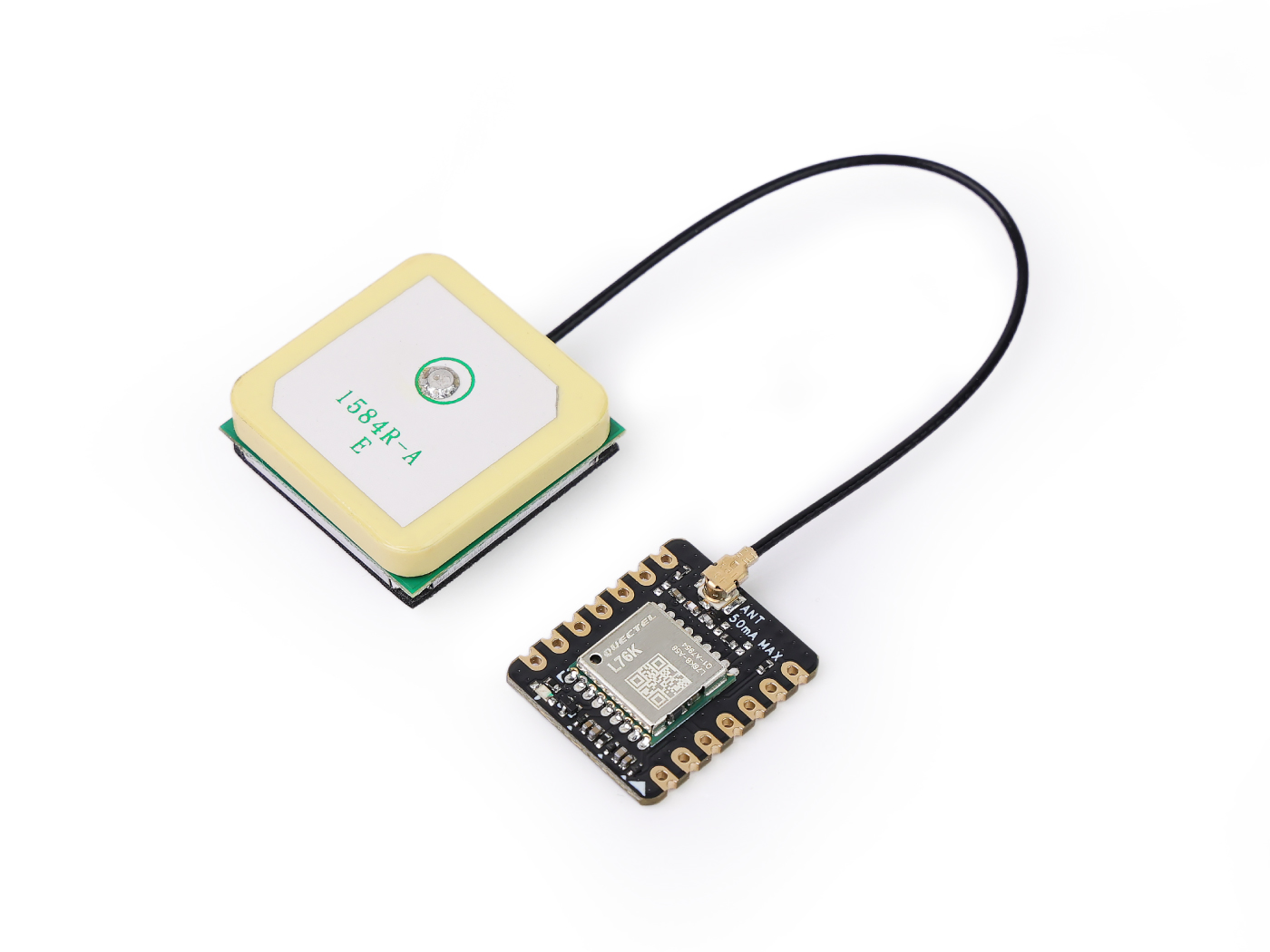
The L76K GNSS Module, specifically designed for SeeedStudio XIAO, is a versatile and efficient Multi-GNSS receiver.
| Specification | Details |
|---|---|
| Size | 18mm x 21mm |
| Update Rate | 1 Hz, 5Hz maximum |
| Baud Rate | 9600 |
| Sensitivity | Auto-acquisition: -148dBm Tracking: -162dBm Re-acquisition: -160dBm |
| Number of Channels | 32 tracking ch/72 acquisition ch |
| Time to First Start (TTFF) | Cold Starts: 30s (w/o AGNSS), 5.5s (w/ GNSS) Hot Starts: 5.5s (w/o AGNSS), 2s (w/ AGNSS) |
| Accuracy | Position: 2.0m CEP Velocity: 0.1m/s Acceleration: 0.1m/s² Timing: 30ns |
Product Applications:
- GPS navigation
- GPS Tracker
- Smart City
- Logistics and Freight Management
Ublox GPS: NEO-6M GPS Module
Considered as one of the more popular GPS modules in the market, the NEO-6M module is a family of stand-alone GPS receivers from the NEO-6 module series.
| Specification | Details |
|---|---|
| Size | 23mm x 30mm |
| Update Rate | 1 Hz, 5Hz maximum |
| Power Requirements | Power Supply Voltage: 3V – 5V |
| Baud Rate | 9600 |
| Sensitivity | -161dBm |
| Number of Channels | 50 |
| Time to First Start | Cold Start: 27s Warm Start: 27s Hot Start: 1s Aided Starts: <3s |
| Antennas | Includes external patch antenna |
| Accuracy | 2.5m GPS Horizontal Position Accuracy |
Product Applications:
- Battery operated mobile devices
- GPS tracker
- GPS navigator
Grove – GPS Module
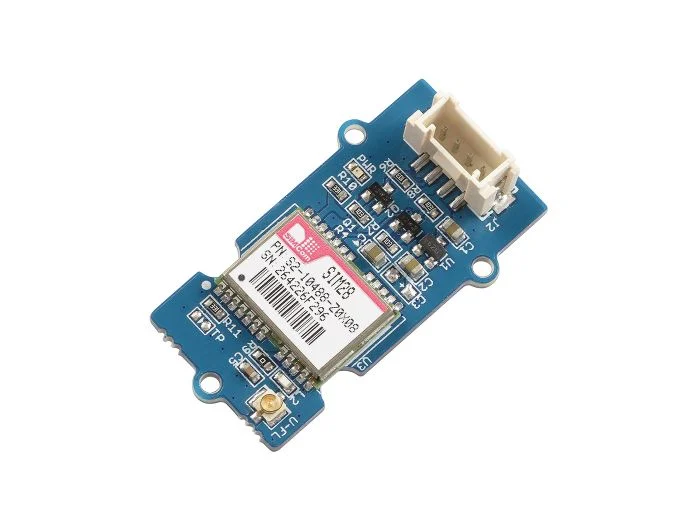
The Grove – GPS Module is Seeed version of a GPS receiver that’s cost-efficient and field-programmable. It’s armed with a SIM28 and serial communication configuration.
| Specification | Details |
|---|---|
| Size | 40mm x 20mm x 13mm |
| Update Rate | 1 Hz, max 10 Hz |
| Power Requirements | 3.3/5V |
| Baud Rate | 9600 – 115,200 |
| Sensitivity | -160dBm |
| Number of Channels | 22 tracking/66 acquisition channels |
| Time to First Start | Cold starts with EASY: 13s Warm Starts with EASY: 1-2s Hot Starts: <1s |
| Antennas | Antenna included in the package |
| Accuracy | 2.5m GPS Horizontal Position Accuracy |
Product Applications:
- GPS tracker
- GPS navigation
- Distance measurement
Other Product Features:
- Low power consumption
- Baud rates configurable
- Grove compatible interface
Grove – GPS (Air530)
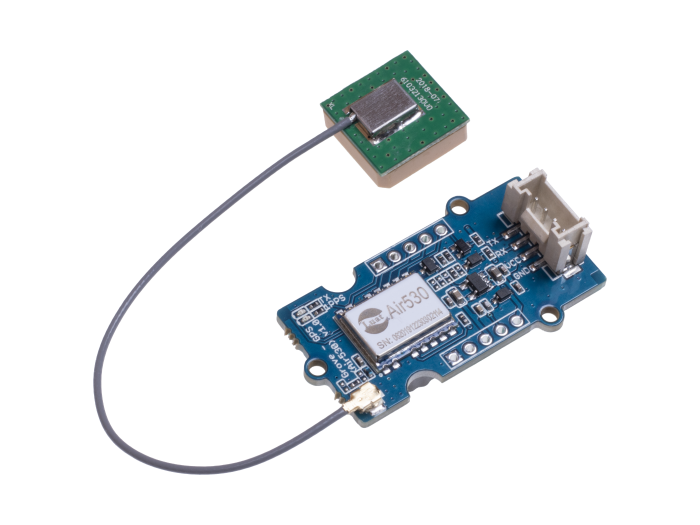
Next up, we have the Grove – GPS (Air530). It’s a high-performance, highly integrated multi-mode satellite positioning and navigation module. It supports GPS / Beidou / Glonass / Galileo / QZSS / SBAS, which makes it suitable for GNSS positioning applications such as car navigation, smart wear, and drone.
If your GPS isn’t working well in urban areas or outdoors under only one or a few satellite modules, you should definitely check out this GPS module. Meanwhile, this module is capable of receiving more than 6 satellites at the same time and is able to work excellently even if there’s a very bad signal.
This GPS adopts the integrated design of RF baseband, which integrates DC/DC, LDO, LNA, RF front-end, baseband processing, 32-bit RISC based chip, RAM, FLASH storage, RTC and power management functions.
Size: 40mm x 20mm x 13mm
Update Rate:
Power Requirements: 3.3/5V
Baud Rate: –
Sensitivity: –
Number of Channels:
Time to first start:
- Cold start: 30 seconds
- Warm Start: 4 seconds
Antennas: Antenna included in the package
Accuracy: 2.5m Horizontal positioning accuracy
Product Applications:
- GPS tracker
- GPS navigation
- Distance measurement
Other Product Features:
- Highly integrated Multi-mode satellite positioning and navigation
- Grove compatible interface
Ublox NEO-6M GPS Module vs Grove – GPS Module vs Grove – GPS (Air530)
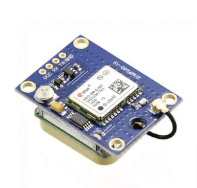
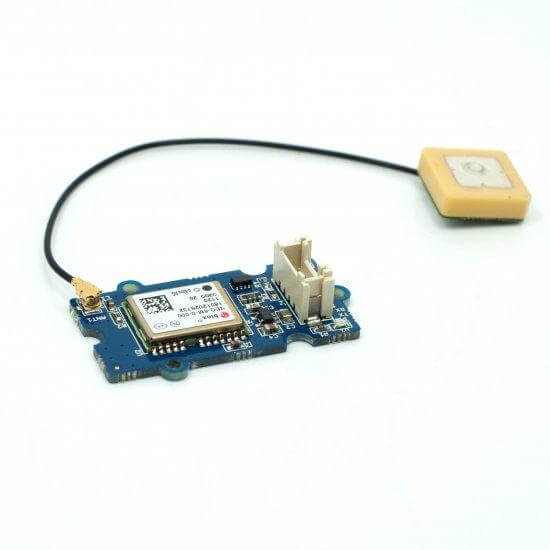
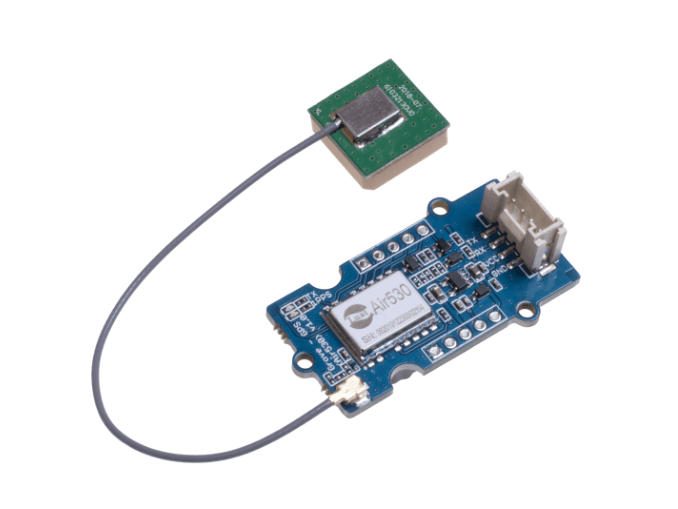
When compared side by side:
| Things to consider | NEO-6M | Grove – GPS Module | Grove – GPS (Air530) |
|---|---|---|---|
| Size | 23mm x 30mm | 40mm x 20mm x 13mm | 40mm x 20mm x 13mm |
| Update Rate | 1Hz, max 5Hz | 1Hz, max 10Hz | – |
| Baud Rate | Default 9,600, max 230400 | 9,600 – 115,200 | – |
| Navigation Sensitivity | -161dBm | -160dBm | – |
| Power Requirements | 3V – 5V | 3.3/5V | 3.3/5V |
| Number of Channels | 22 tracking, 50 channels | 22 tracking, 66 channels | – |
| Time to first start | Cold start: 27s Warm start: 27s Hot start: 1s | Cold start: 13s Warm start: 1-2s Hot start: <1s | Cold start: 30 seconds Warm Start: 4 seconds |
| Antennas | External patch antenna | Antenna included | Antenna included |
| Accuracy | 2.5m GPS Horizontal Position Accuracy | 2.5m GPS Horizontal Position Accuracy | 2.5m Horizontal positioning accuracy |
Which GPS Module is better?
Better power consumption:
The Grove – GPS (Air530) has a ultra-low power consumption at only 31uA, low power mode at 0.85 mA making the Air530 the better GPS with lower power consumption.
Scalability:
With a higher maximum update rate, the Grove GPS Module is able to be used for projects that involve objects that travel at a faster speed. Furthermore, having more channels open up for other applications as well.
The Grove- GPS (Air 530) has a multi-mode satellite positioning & navigation and supports more than 6 satellites at the same time.
Accuracy:
Featuring Horizontal positioning accuracy of 2.5m, High positioning accuracy of 3.5m, speed accuracy of 0.1m/s, and a time transfer accuracy of 30ns, the Grove -GPS (Air530) is able to position quickly and accurately even under the condition of a bad signal.
Pair your GPS modules with:
Seeeduino, Seeed very own Arduino Board:
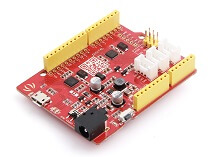
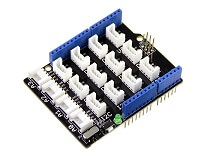
Seeduino V4.2 is Seeed version of an Arduino, which can be used to pair with your GPS modules.
The base shield is designed for better ease of connecting the Grove GPS Module.
Hardware configuration :
- Connect Grove-GPS to port D2 of Grove Base Shield
- Plug Grove – Base Shield into Seeeduino
- Connect Seeeduino to PC via a USB cable
For software and further configurations, you can head here
Raspberry Pi
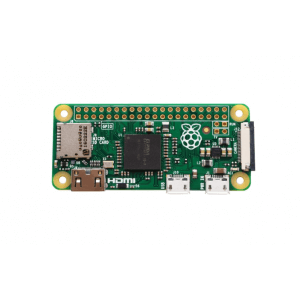
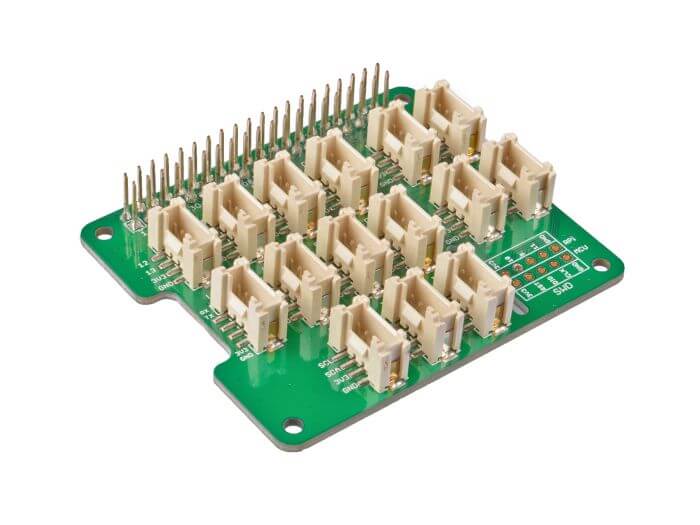
If you do not own a raspberry pi yet, you can consider picking up a low-cost RPI Zero alongside with the Grove Base Hat to pair the Grove GPS Module.
If already you own a Raspberry Pi 2/3B/3B+/4/Zero, you can simply pair it with the Grove Base Hat.
Both the hardware and software configurations can be found here
Commuity GPS Project
Now that you have just picked your GPS module, here are some projects that you can do with your GPS module.
Incorporating GPS and solar-power to environmental sensors

Antonio Ruiz wants to make this project cuz, he wants the determination of environmental factors such as humidity, light intensity, or gas concentrations is essential in a wide range of applications, including crop production and field characterization.
What do you need?
- Adafruit Medium 6V 2W Solar panel – 2.0 Watt
- Sensirion SCD30 CO2 sensor module
- DFRobot Gravity: Analog Capacitive Soil Moisture Sensor- Corrosion Resistant
- Seeed Studio Soil Moisture & Temperature Sensor
- Rechargeable Battery, Lithium Ion
- Adafruit Solar Lithium Ion/Polymer charger
- Seeed Studio Grove – GPS
- Wio Terminal
If you are interested, you can check out the full tutorial by Antonio Ruiz on Hackster
Create Your Own LoRa GPS Tracker Using Wio Terminal

Ramin Sangesari’s project has explained how the GPS works and the device information that you are gonna use in this project.
What do you need?
- Wio Terminal
- Grove – LoRa Radio 868MHz
- Grove – GPS (Air530)
- Grove – Actice Buzzer
- Grove – Button
- Polymer Lithium Ion Battery
- Seeeduino XIAO
- Grove Shield for Seeeduino XIAO
- SparkFun Arduino Pro Micro
- 5V Lithium Battery Charger
If you are interested, you can check out the full tutorial by Ramin Sangesari on Hackster
Vehicle Tracking System

With a GPS module together with the Arduino, you can easily install a vehicle tracking system in your car. In the event your car gets stolen or you forgot where you parked it, you can easily track your car with your mobile phone through this project.
What do you need?
- Arduino UNO / Seeeduino v4.2
- GPS Module
- Grove 16×2 LCD (White on Blue)
- GSM sim800/900 module
- Jumper Wire
Interested? You can check out the full tutorial by Muchika on Arduino Project Hub.
LED Bike Speedometer
Want to find out how fast you are riding? With this DIY bike speedometer, using GPS technology for speed sensing, you can tell how fast you are going! It also features an RGB LED to indicate the speed to the rider.
What do you need?
- Arduino Pro Mini
- GPS Module
- Grove – Variable Color LED V1.1
- LiPo Battery
- Charging Module
- Grove – Switch(P)
- Grove – Button
- 3D Printer (For enclosure)
Interested? You can check out the full tutorial by Jeremy S. Cook on Arduino Project Hub.
Personal GPS Assistant
This project is a device that lets you monitor people and things, and tell you continuously their location, and the values of the sensors attached to it.
One of the feature allows you to set limit values for the sensors, and when these are exceeded an SMS alert is sent to you. You can also set restrictions from some places, where alerts will be given to you when the device leaves the area.
It’s also possible to communicate with the device through SMS, in order to get information about it.
What do you need?
- Grove Starter Kit for LinkIt ONE
- Grove Starter Kit Plus – IoT Edition
- GPS Module
- Arduino UNO / Seeeduino v4.2
- Google Maps Software
- Pubnub Publish Software
- jQuery Software
- Chart.js Software
- ArduinoJson Software
Interested? You can check out the full tutorial by Mohamed Fadiga on Arduino Project Hub.
Portable GNSS products
In addition to community projects, there’s a growing interest in portable GNSS products, which offer advanced capabilities in compact, user-friendly packages. These products are ideal for a range of applications, from personal tracking to professional asset management.
SenseCAP T1000 Tracker
Meet the SenseCAP T1000 Tracker, your simple solution to the complex world of location tracking. Whether you’re indoors surrounded by Wi-Fi and Bluetooth signals, or out in the vast openness where GNSS is your guide, the T1000 adapts effortlessly.

The T1000 sets itself apart with its robust compatibility, seamlessly integrating with leading LoRaWAN® network servers such as The Things Network (TTN), Helium, Loriot, and Amazon Web Services (AWS). The device’s flexibility is matched by its ease of use with popular IoT dashboards like Datacake and Ubidots, which transform raw data into actionable insights.

Explore the SenseCAP T1000 Tracker in detail on the official Seeed Studio Wiki here.
Update Log
January 29, 2024 – By Spencer
- Updated Imagery: Replaced missing images with DALL-E
- Format Information: Arrange the product details into a table.
- Added L76K GNSS Module For XIAO: Introduced a new navigation module for XIAO
- Introduction of T1000 Series: Include information about the SenseCAP T1000 GPS tracker
